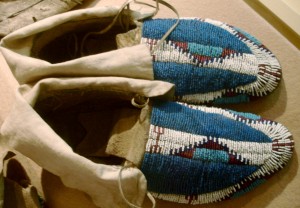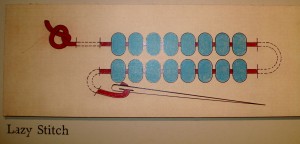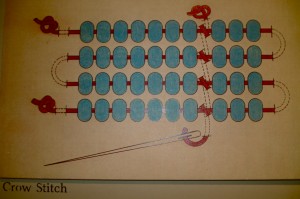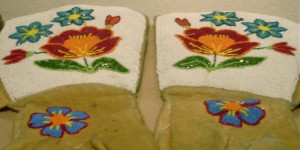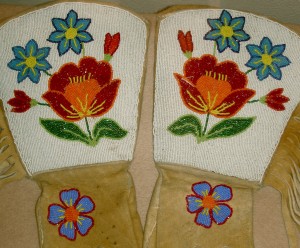There were not specific borders defining the state lines to the Native Americans; they were hunter and gatherers, which means they had a free range lifestyle. Pinning the exact location of the Native American tribes in the North West during this time is difficult, they were constantly on the move going where the buffalo herds took them. Beadwork played an integral part in the lives of Native American women. It served for both practical and ceremonial purposes. While beadwork was used to decorate everyday items including vests, bags, beaded gloves, and shoes were venerated as ceremonial and trade objects.
Before the Europeans arrived in the New World with glass beads, many of the Native American tribes traded with each other using wampum beads as currency. Wampum beads were a type of bead that was handmade from the quahog or hard-shell clam.(1) It came in only two colors: white and dark purple. Wampum beads were only about one-quarter inch in length and one-eighth inch in diameter. Glass beads soon replaced the use of Wampum when the Europeans arrived. Beads were used for currency.(2) Italians created the first seed beads that natives originally traded for. Later, Czech seed beads became the leading material after 1890. White seed beads were the most common beads across tribes. The Nez Percè tribe, common to the Idaho area, mainly used white, light blue, brown, red, and green. Trade played a major factor into the materials that tribes had at their disposal.
There were certain colors that were valued higher than others to some tribes. The Europeans soon realized that the regions of land determined the value of certain items because of the inhabiting tribes.(3) Italians created the first seed beads that natives originally traded for. Later, Czech seed beads became the leading material after 1890. White seed beads were the most common beads across tribes. The Nez Percè tribe, common to the Idaho area, mainly used white, light blue, brown, red, and green. Trade played a major factor into the materials that tribes had at their disposal.(4) For trading there was a certain common rate of exchange everyone knew about:
Green beads with white centers:
Six = one made beaver
Transparent pea-size green and yellow beads:
Six = one made beaver
Large amber, transparent blue, or opaque beads:
Two = one made beaver
Large opaque blue beads:
One = two made beavers
*A made beaver was a beaver hide that had been cleaned, scraped, stretched, and prepared for shipment.(5)
Stitching is one of the key components after the hide has been prepared to be worked on. There are various styles of stitching techniques that can be discussed when assessing Native American beadwork. It is important to note that there are a number of tribes that use the same basic beadwork techniques. It is possible that one may encounter other styles of beadwork, but they can generally associate with one of these four categories.(6)
Lane Stitch or Lazy Stitch
The lane stitch is the most widely used style of Native American bead work. It is characterized by rows, also called humps of beads that are sewn down to buckskin or canvas. Generally there are seven to eleven beads sewn into a stitch or lane. Lane stitch work has a hard feel to it because the holes of the beads are filled with as much thread as possible pulling the stitches tightly. Because this kind of beadwork can be done quickly, it is usually used to make large pieces.(7)
Cheyenne Loop Stitch
The Cheyenne loop stitch uses a variation of lane stitch beadwork having the beads in all rows, but with the first sewn down on only one side. The other side of the row is then looped around the threads of the row just below it. Along with the lane stitch loop stitching should exhibit a hard feel, but tends to look flatter than lane stitching. Both of these types of stitching were probably the first learned techniques of Native Americans and most commonly used.(8)
Crow Running Stitch
“Crow stitch is generally done with two needles; the first thread strings the beads and the second thread tacks the first thread down every few beads.”(9)
Beads are tacked down all at one time and on a given piece may vary from three to six to ten. Because so many beads are used in the crow stitch this type of work tends to have some movement and its work is usually characterized in having wavy lines and rounded corners, thus having a bumpy appearance. This type of bead work is often used to make rifle cases, shirts, and dress tops.(10)
Return stitch
The return stitch is a technique where two beads are strung and sewn through backing material. Next the needle is brought back between the row of beads and strung through the last bead. This type of bead work is most commonly used when the precise placement of the bead is needed such as in the making of geometric designs.(11) Along with stitching there were other ways the Native American women use when creating the complex designs for their pieces. Two different forms of beading the Native American women primarily used were the strung chain and the loom. The simplest form of beadwork is a strung chain. Many people learn how to string the beads into a necklace at a young age.
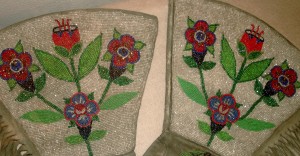
Idaho Historical Society - Native American women traded these types of items to the white man for profit.
They often used silk or dental floss for the main part of the necklace. The necklaces could be doubled and very intricate with pearls and tassels. A more complex form of beading is on a loom.(12) The loom beading is also the most popular form of beading. It is popular because it is simple and affordable. An average loom made of metal can cost anywhere from $6-50 dollars. However, many women on the frontier preferred homemade looms to do their beadwork. Loom beading was also the most common for Native American Indians to use.
They favored the loom because they could stop at any point and not lose their place. They could also have both hands free to make the beads and needle do exactly what they wanted.(12) A common but not expected form of beading is to make a homemade loom out of a cigar box. They chose the cigar box as their base because they were the most accessible. The man on the early frontier would often trade for cigars, which came in the perfect size box. The women would not waste the box. They were resourceful and took advantage of what they had around them. A cigar box loom was also used for teaching children how to bead. Cigar boxes are the perfect size for children’s hands to operate.(14)
Children also helped to build the loom, which gave them a sense of pride and craftsmanship. When weaving with the loom you should always have an extra piece of warp thread to ensure that there is an adequate amount of thread on both sides of the beads. The bow loom was another way a useful way for women to weave belts and rectangular shapes in the beads.(15) The shape of the bow loom allowed for the beads to be formed into the round shape that was needed in a belt. Another form of beading is diagonal beading without a loom. You can vertically weave with the beads without the assistance of the loom. The use of a needle is used in this method. The needle and thread run through alternate beads to create the vertical appearance. The last type of beadwork is on a canvas. This type of bead work is common but very difficult to accomplish. It takes the most amount of focus and concentration. The most experienced bead workers were the only ones able to bead on canvas. Canvas is very delicate and you had to know exactly what you were doing with every stitch. There was no room for mistakes.(16)
Among beadwork of the Blackfeet tribe of the Pacific Northwest, embroidery designs generally followed either the tribal tradition or floral-based designs. Within the tribal tradition, patterns consisted of geometric figures most notably squares, rectangles, and triangles.(17) Of the various designs employed by various Native American tribes the “mountain designs,” which consisted of a series of small squares in the form of a triangle, was very common. Other geometric designs including stripes and transverse bars have also been found on containers in addition to traditional clothing.
While geometric figures characterized the tribal tradition, images of flowers and leaves of the floral tradition are believed to have been developed after the presence of the white settlers. Floral designs which “seem to have been directly or indirectly inspired by the flower designs appearing in the embroidery of White people” had been employed only since the first half of the nineteenth century.(18) Among floral patterns, Blackfeet women would often press leaves to create patterns after which were then decorated with beads. Items including moccasins, breech cloths, gauntlets, clothing, pouches, and saddle bags are often decorated within the floral design framework.(19) The rosette, a solid circle of beadwork, although not always floral-based evolved into generally resembling floral patterns.(20) Clothing and leggings decorated with beadwork generally had ceremonial purposes. Otherwise, clothing used on a daily basis was undecorated and plain. Beaded clothing was a good way to characterize social status for both men and women.
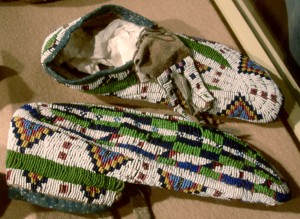
Idaho Historical Society - The beaded outsoles on the shoes indicate that they were used for ceremonial practices.
In addition to preserving Native American culture and heritage, beadwork has evolved into something more than serving traditional purposes. Within “Beadwork and Mathematics,” Jim Barta investigated using beadwork for educational purposes. Barta illuminated the practice of Native American children using beadwork to understand mathematical concepts while retaining and practicing cultural traditions. “When I am showing my children how to create a border say for their moccasins they are making, I have them skip count. Even the young children catch on quickly as they count by threes, fours, or fives depending on the width of the border they are making.”(21) Through beading Native American children practice geometry, fractions, counting, ratios, properties of time, etc. while continuing their native traditions.
Awls made from buffalo shoulder or leg bone were often the only tool used in Native American beadwork. Awls were used as a pick to sort and separate threads and to punch holes in hide. By punching holes in soft buckskin, sinew could be threaded to attach beads.(22) As technology and trade improved, iron and steel awls became common place. Steel awls, in particular, became the preferred tool. Native women used these needles until they were dull, sharpened them again until they were unusable.
Thread was originally made of sinew or plant fibers that were braided or twisted into thread. Sinew is prepared when an animal is killed for meat. To prepare sinew, it must be scraped to remove all fat. It must then be dried slowly to stiffen the rawhide. From this, small strips of fiber can be pulled off. When it is time to thread, these strips must be soaked in water. Before needles were introduced, native women would twist the top of the strip to form a point.(23) The drawback to using natural materials is that it attracts bugs that feed on the material which leads to deterioration. Horsetail hairs were also an option. These, however, did not require a needle. Threads were commonly coated with beeswax to increase the lifespan, protect from insects, and keep from tangling. With an increase in trade, European threads were introduced. Because these materials were of much higher quality, they became the material of choice.(24)

Idaho Historical Society - This multi-purpose bag was used to carry personal items from place to place when the Native Americans would be on the move.
Native women used brain-tanned buckskin or fine woolen for the backing material. Brain-tanned buckskin was conditioned rawhide that was smoked to keep it soft and pliable. Fine woolens were handled by early traders. These finely woven wool fabrics were used to make the military uniforms of the day.(25) These became the common trade item of the 1700s and 1800s. To cut rawhide and threads, knives that were first built from chipped flint were used. Later, these knives were made of iron or steel. These knives, which were usually less than 4 inches long, were used for multiple jobs around the camp. Once scissors became a trade good, they caught on fast due to their ease and convenience.(26)
Italians created the first seed beads that natives originally traded for. Later, Czech seed beads became the leading material after 1890. White seed beads were the most common beads across tribes. The Nez Percè tribe, common to the Idaho area, mainly used white, light blue, brown, red, and green. Trade played a major factor into the materials that tribes had at their disposal.(27)
From the 1900’s to until the end of World War II Native Americans beadwork was nothing more than tourist curiosities. Post World War II Native Americans were excited because there were “new warriors” returning home.(28) Warriors in the Native American culture are the people most deserving of respect and honor. With these heroes returning home there would be much need for new beadwork to decorate their clothes for powwow.(29) In result of this there were many collectors of Native beadwork materials, willing to pay large amounts. Beadworkers began to achieve a reputation among the collectors; beadwork was now being seen as an art and not just a craft. As travel became more available by automobile and planes more Native American tribe gatherings were popping up all across the country.(30) The tribal beadwork styles became blurred and a new style was developed call Pan-Indianism. This style blends a number of different styles; for the most part it includes obscured tribal identity. In the 1980’s and 1990’s Native American beadwork began to be studied in-depth, which created a renaissance of many of the older styles.(31) Native American beadwork is in a state of change; many changes are due to the easy access to Japanese beads and new techniques. The largest change seen today is that of the artist and having an open mind to step out of the box, to break some of the traditional beadwork that they have used for many generations. Today it is common to find Native American artists creating jewelry, wall hangings like dream catchers, modern beaded clothing, and accessories.(32)
Photo credit: Idaho Historical Society; Idaho History Museum, Boise, Idaho.
(1) Dean, David. Beading in the Native American Tradition. Loveland, Colo: Interweave Press, 2002.
(2) Ibid.
(3) Ibid.
(4) Ibid, 4.
(5) Ibid, 26.
(6) Ibid.
(7) Ibid, 7.
(8) Ibid.
(9) Ibid, 16.
(10) Ibid.
(11) Ibid, 18.
(12) Ibid.
(13) White, Mary. How to Do Beadwork. New York: Dover Publications, 1972.
(14) Ibid.
(15) Ibid.
(16) Native Languages of the Americas. Native American Beadwork. Native Languages of America. www.native-languages.org/faq.htm.
(17) Ibid.
(18) Ewers, John C. Blackfeet Crafts. [Lawrence, Kan.]: U.S. Indian Service, 1945.
(19) Ibid.
(20) Monture, Joel. The Complete Guide to Traditional Native American Beadwork: A Definitive Study of Authentic Tools, Materials, Techniques, and Styles. New York: Collier Books, 1993.
(21) Dean, David. Beading in the Native American Tradition. Loveland, Colo: Interweave Press, 2002.
(22) Ibid, 26.
(23) Ibid.
(24) Ibid, 28.
(25) Ibid.
(26) Ibid.
(28) Ibid, 29.
(29) Ibid.
(30) Ibid.
(31) Ibid, 4.
(32) Ibid, 5.
